FDMA, TDMA, and CDMA are important key techniques in multiple access.
Multiplexing Vs Multiple Access:
Multiplexing allows multiple information signals to be transmitted concurrently over a single communication channel, combined into a complex signal.
Multiple Access is a method that permits multiple users to access the channel at the same time while maintaining signal quality and avoiding interference.
Multiple Access is an application of Multiplexing.
Table of Contents
FDMA
FDMA (Frequency Division Multiple Access) is a digital modulation technique used in wireless communication systems to allow multiple users to share the same frequency band. It is a method of multiplexing, where multiple signals are transmitted over a single communication channel, separated by frequency.
How does FDMA work?
1. Frequency Allocation: The available frequency band is divided into smaller sub-bands, each allocated to a specific user or device.
2. Signal Transmission: Each user’s signal is transmitted on their allocated frequency sub-band.
3. Signal Reception: The receiver tunes into the specific frequency sub-band to receive the signal.
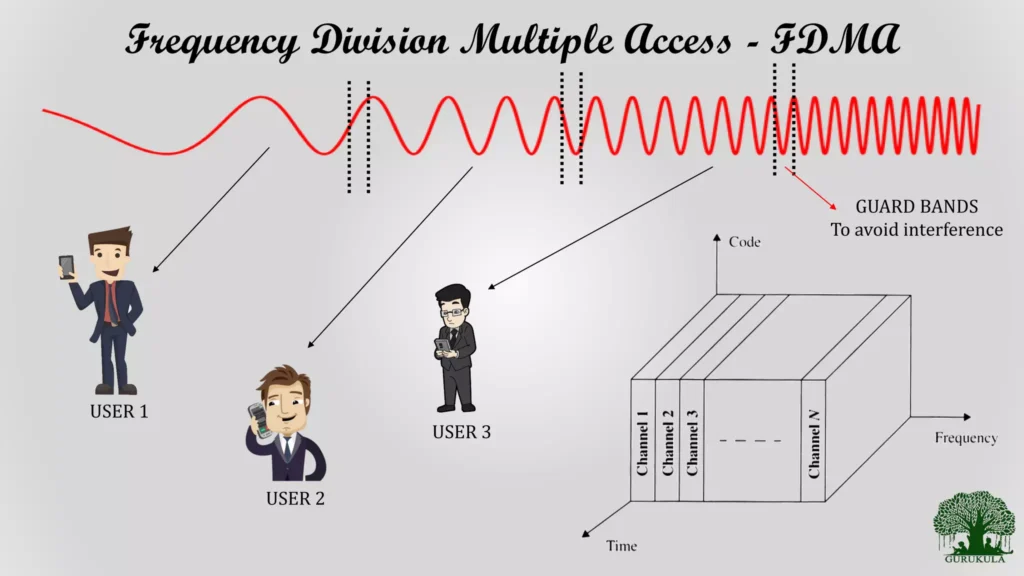
ref: google image
- Users are assigned specific channels using FDMA.
- Every user has their own channel or frequency band assigned to them.
- The users designate the channels as needed.
- Two distinct users do not get the same frequency.
- The FDMA channel has a relatively small bandwidth of about 30 KHz.
- Narrow-band systems are often where this access is implemented.
- Because of the low inter-symbol interference in FDMA narrow-band systems, equalization is unnecessary.
- Compared to TDMA, FDMA is a continuous transmission method with less overhead. A duplexer is used by the system, although at a similar cost, to enable simultaneous transmission and reception.
- To reduce interference from adjacent channels, strict filtering is necessary.

Non-Linear Effects in FDMA
- Many channels in FDMA share a single antenna at the base station.
- For improved power efficiency, power amplifiers, and combiners are operated at a point close to saturation, where they can deliver maximum output with minimal excess energy.
- The power amplifiers and power combiners are non-linear in or near the saturation zone.
- These non-linearities result in intermodulation (IM) frequencies and signal dispersion in the frequency domain.
- Adjacent channel interference will result from this spreading interfering with the neighboring channel.
Capacity of FDMA
The number of channels that can be simultaneously supported in FDMA systems is given by
N=(Bt-2BGuard/BC)
Where
Bt is the total spectrum allocation
BGuard is the Guard Band allocation at the edge of the allocated spectrum
Bc is the channel bandwidth
Advantages
1. Efficient Spectrum Utilization: It allows multiple users to share the same frequency band, maximizing spectrum efficiency.
2. Reduced Interference: It minimizes user-to-user interference, as each signal is transmitted on a separate frequency sub-band.
3. Simple Implementation: FDMA stands out for its straightforward implementation and minimal infrastructure requirements.
4. Low Cost: FDMA’s simplicity makes it a cost-effective solution, as it doesn’t necessitate intricate infrastructure or advanced technology.
5. Wide Coverage: It can provide wide coverage, making it suitable for rural or remote areas.
Disadvantages
1. Limited Capacity: It has limited capacity, as the number of users is restricted by the available frequency sub-bands.
2. Inflexibility: It is inflexible, as changing the frequency allocation requires significant infrastructure modifications.
3. Vulnerability to Interference: It is vulnerable to interference, as a single strong signal can disrupt the entire frequency band.
4. Difficult Frequency Planning: FDMA requires complex frequency planning to ensure efficient spectrum utilization.
5. Not Suitable for High-Speed Data: FDMA is unsuitable for high-speed data transmission as it can lead to data congestion and errors.
6. Not Scalable: FDMA is unscalable, as increasing the number of users requires additional frequency sub-bands.
7. Security Concerns: FDMA has security concerns, as signals can be easily intercepted or jammed.
Applications
- First-Generation (1G) Cellular Networks: Frequency Multiple Division Access was the foundational multiple access technique in early analog cellular networks like AMPS (Advanced Mobile Phone System). While largely replaced by more advanced techniques, it paved the way for modern mobile communication.
- Satellite Communication: Frequency Multiple Division Access remains an important technology in satellite communication systems, especially for broadcasting and certain point-to-point links. It enables multiple satellite channels to coexist within a limited frequency spectrum, maximizing available bandwidth.
- Trunking Radio Systems: Frequency Multiple Division Access is utilized in some trunking radio systems, where multiple users share a pool of channels. It allows efficient allocation of channels based on demand, improving system capacity and performance.
- Cordless Telephones: Many older cordless telephone systems still employ Frequency Multiple Division Access for communication between the handset and the base station. While being phased out in favor of newer technologies, it remains a relevant application for legacy devices.
- Maritime and Aeronautical Communication: Certain maritime and aeronautical communication systems employ Frequency Multiple Division Access. It enables reliable voice and data communication over dedicated frequency bands essential for safety and navigation.
Conclusion
Frequency Multiple Division Access is a widely used digital modulation technique that enables multiple users to share the same frequency band. While it has limitations, FDMA remains an essential technology in wireless communication systems, offering efficient spectrum utilization and reduced interference.
TDMA
TDMA (Time Division Multiple Access) is a digital multiplexing technique used in wireless communication systems to allow multiple users to share the same frequency band. It is a method of multiplexing, where multiple signals are transmitted over a single communication channel, separated by time.
How TDMA Works?
1. Time Slot Allocation: The available time is divided into smaller slots, each allocated to a specific user or device.
2. Signal Transmission: Each user’s signal is transmitted in their allocated time slot.
3. Signal Reception: The receiver tunes into the specific time slot to receive the signal.
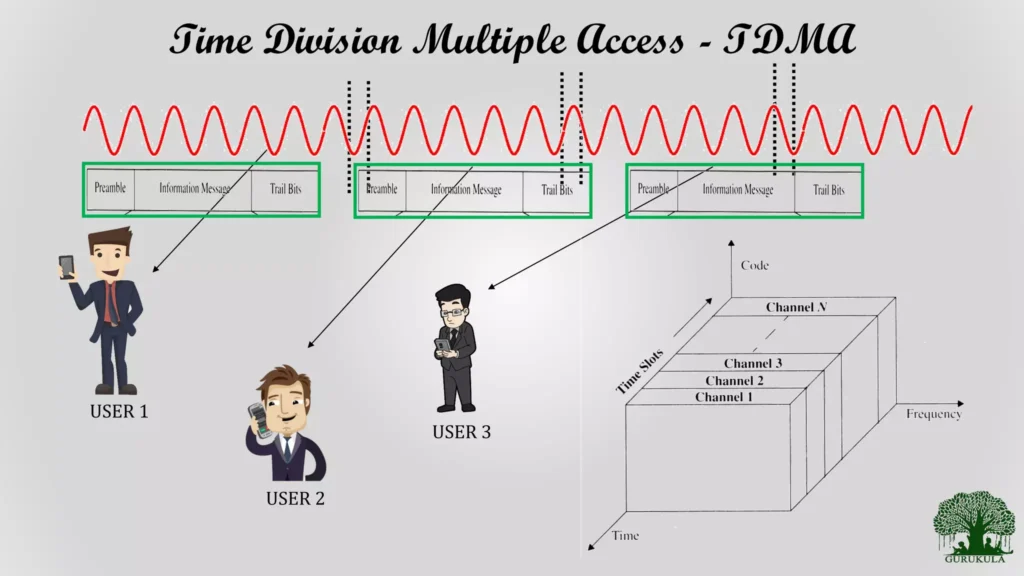
ref: google image
- Within the radio spectrum, time slots are assigned using Time Division Multiple Access, permitting only one user to broadcast or receive at a time.
- Every user has a time slot that repeats cyclically.
- The data transmission in a Time Division Multiple Access system is discontinuous because it uses the buffer and burst approach.
- As a result, Time Division Multiple Access systems are better suited for digital systems.
- Systems that require duplexing and multiple access employ TDMA/TDD or TDMA/FDD techniques.
- The signal frame is split into two halves in TDMA/TDD: one half is used for the forward link and the other for the reverse link.
- Though the carrier frequency varies, two frames are utilized for forward and backward links in TDMA/FDD.
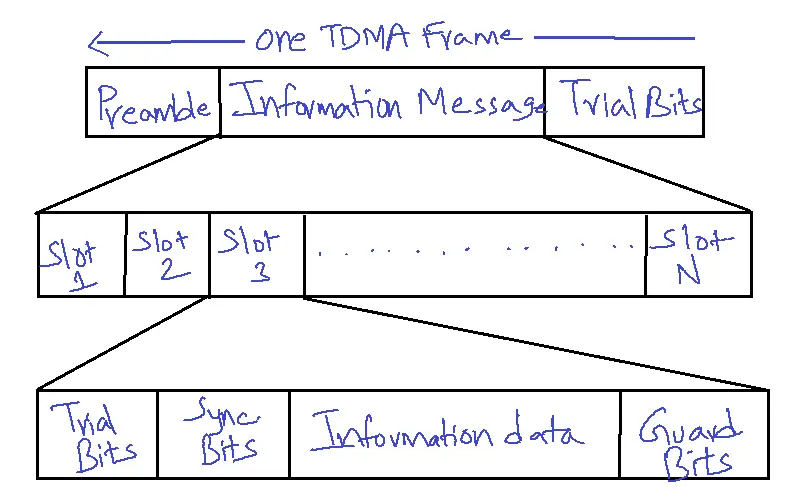
Preamble: Consists of address and synchronization bits used by base station subscribers to identify each other.
Information Message: Contains multiple slots of user information.
Each slot will have
- Trial bits
- Sync bits
- Information
- Guard Bits
Features of TDMA
- When using Time Division Multiple Access, several users share a single carrier frequency, variables, including available bandwidth and modulation schemes, influence users’ choice of time slots.
- The handoff process is significantly simpler in the case of Time Division Multiple Access because of its discontinuity and it may listen to the other base stations during its idle slot time.
- Because adaptive equalization is required in the case of TDMA, the transmission rates are much higher concerning FDMA.
- In the event of Time Division Multiple Access, the guard time should be as short as possible.
- The affordability of Time Division Multiple Access is one of its main advantages.
- By dividing time slots into discrete chunks, TDMA keeps concurrent transmissions from interfering.
Efficiency
Efficiency calculations become simple since Time Division Multiple Access has a larger overhead than FDMA.
The proportion of data that is transmitted and informative as opposed to serving as scheme overhead is the TDMA system’s efficiency.
Frame Efficiency(nf) is calculated by
nf=(1-(bOH/bT)) X 100%
bOH– number of overhead bits per frame
bt– Total Number of bits per frame
bOH= NrBr+NtBp+NtBg+NrBg
Nr– Number of reference bursts per frame
Br– Number of overhead bits per reference burst
Nt– Number of traffic bursts per frame
Bp– Number of overhead bits per Preamble in each slot
Bg – Number of equivalent bits in each guard time interval
Number of Channels in the TDMA system
The number of TDMA slots per channel multiplied by the total number of channels available yields the TDMA channel slots offered in a TDMA system.
N=m(Btot-2BGuard)/Bc
m- maximum number of TDMA users supported in the channel
Note that to prevent users at the edge from spilling over into a neighboring radio channel, there must be two guard bands: one at the lower end and the other at the upper end of the allocated frequency.
Advantages
1. Efficient Spectrum Utilization: Time Division Multiple Access allows multiple users to share the same frequency band, maximizing spectrum efficiency.
2. Reduced Interference: Time Division Multiple Access minimizes user-to-user interference, as each signal is transmitted in a separate time slot.
3. Flexible Allocation: Time Division Multiple Access allows for flexible allocation of time slots, enabling efficient bandwidth usage.
4. Simple Implementation: Time Division Multiple Access stands out for its straightforward implementation, requiring minimal infrastructure compared to other multiple access techniques.
5. Low Cost: Time Division Multiple Access stands out for its cost-effectiveness, requiring minimal infrastructure and straightforward technology.
Disadvantages
1. Limited Capacity: Time Division Multiple Access capacity is constrained by the finite number of available time slots for users.
2. Vulnerability to Timing Errors: Time Division Multiple Access is vulnerable to timing errors, which can disrupt the entire network.
3. Not Suitable for High-Speed Data: Time Division Multiple Access is not recommended for high-speed data transmission, as it can lead to data congestion and errors.
4. Synchronization Challenges: Time Division Multiple Access requires precise synchronization between transmitters and receivers, which can be challenging.
5. Limited Scalability: While Time Division Multiple Access provides efficient channel sharing, its scalability is constrained by the need for more time slots to support additional users, which can increase system complexity.
Applications
- 2G Cellular Networks (GSM): Time Division Multiple Access was a core technology in second-generation cellular networks like GSM, enabling multiple users to make voice calls and send text messages simultaneously over the same frequency channel.
- DECT (Digital Enhanced Cordless Telecommunications): Time Division Multiple Access is employed in DECT cordless phone systems, providing multiple channels for voice communication within a home or office environment. Its low interference and good voice quality make it suitable for these applications.
- Satellite Communication Systems: Satellite communication leverages Time Division Multiple Access to effectively share transponder capacity among numerous ground stations, enabling concurrent transmission and reception of diverse signals like data, voice, and video.
- Combat-Net Radio Systems: Time Division Multiple Access finds applications in military combat-net radio systems, providing secure and reliable communication in challenging environments. Its ability to allocate time slots dynamically enhances flexibility and efficiency in these systems.
- Passive Optical Networks (PON): Time Division Multiple Access is used in the upstream direction of PON networks to enable multiple users to share the same fiber optic link for data transmission. It allows for cost-effective broadband access in residential and business areas.
Conclusion
Time Division Multiple Access is a widely used digital multiplexing technique that offers efficient spectrum utilization, reduced interference, and flexible allocation. However, it has limitations regarding capacity, vulnerability to timing errors, and scalability. TDMA is suitable for applications with low-to-medium traffic density and simple communication requirements.
CDMA
CDMA (Code Division Multiple Access) is a digital multiplexing technique used in wireless communication systems to allow multiple users to share the same frequency band. It is a multiplexing technique, where multiple signals are transmitted over a single communication channel, separated by unique codes.
How CDMA Works:
1. Unique Codes: Each user is assigned a unique code, which is used to encode and decode their signal.
2. Signal Transmission: Each user’s signal is transmitted simultaneously over the same frequency band.
3. Signal Reception: The receiver uses the unique code to decode and extract the intended signal.
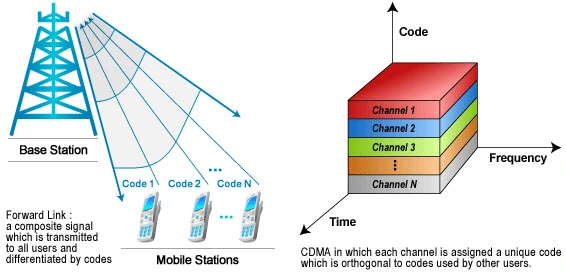
ref: google image
- The spreading signal, a high bandwidth signal, is multiplied by the narrow band message signal in CDMA systems.
- All those spreading signals are PN sequences with chip rates higher than the message’s data rate.
- With CDMA, each user may broadcast concurrently and is modulated using the same carrier frequency.
- Every user has a pseudorandom code word that is roughly perpendicular to every other code word.
- InCode Division Multiple Access systems, orthogonal spreading codes are essential to reduce mutual interference between several users.
- The receiver utilizes the temporal correlation function to render all signals except the intended one uncorrelated, and to decode the communication signals successfully, the recipient must possess knowledge of the specific code phrase.
- In a CDMA system, the user’s power level dictates the noise level, and poor power control can cause a near-far problem, where low-power users are blocked from accessing the network and receiving service due to interference from stronger signals.
CDMA-Pros and Cons
- The capacity of many users under Code Division Multiple Access is soft-limited, in contrast to TDMA and FDMA. Power will grow as the number of users in the system increases.
- There is no strict limit on the number of users that can be added, but the system’s performance deteriorates with each additional user, leading to decreased quality and reliability.
- A wide bandwidth is covered by the signal, significantly reducing multipath fading.
- In Code Division Multiple Access systems, channel data rates are quite high.
- Signals that are delayed by more than one chip duration are considered noise, as the symbol period is significantly shorter than the channel’s delay spread, making longer delays indistinguishable from noise
- By gathering delayed copies of the necessary signal, rake receivers enhance reception.
- A Code Division Multiple Access issue known as the “self-jamming problem” develops when the PN sequence is not orthogonal.
- The near-far dilemma arises when weaker signals from the intended user, who is farther away, are overwhelmed by signals from undesirable users closer to the receiver.
Near-Far Problem
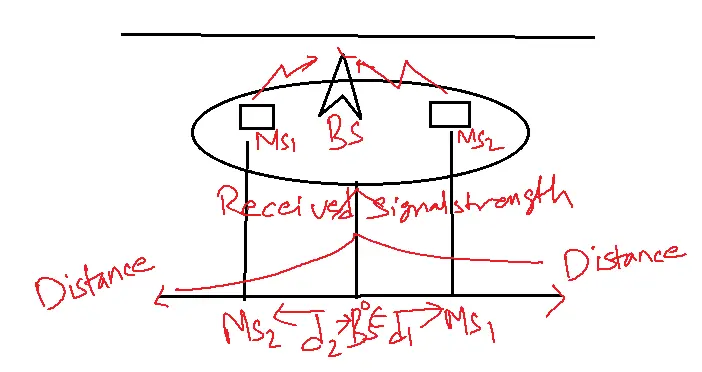
- Channel Capacity: The Shannon Theorem states that there is a direct proportionality between SNR and channel capacity. Reduce the SNR and the capacity.
- Service Degradation: The equipment at the cell edge broadcasting at a greater power to maintain a decent SNR at the base station causes increased interference, which lowers the SNR and decreases the quality.
- Battery Drain: When users are distant from the base station, their battery life is shortened. because to keep the base station’s SNR high, it must broadcast at a greater power.
Capacity of CDMA systems
Unlike FDMA and TDMA, the capacity of a Code Division Multiple Access system is determined by how much interference it can withstand rather than by bandwidth.
Consequently, every decrease in interference will result in a linear rise in Code Division Multiple Access systems.
The number of users that can access the system is given by
N=1+[(W/R)/(Eb/N0)]-(n/s)
W/R →Processing Gain
n→background thermal noise
S→Power of each user
N→Number of users
Key Benefits
1. High Capacity: A large user capacity within the same frequency band is facilitated by CDMA technology.
2. Improved Security: Code Division Multiple Access signals are difficult to intercept and decode without the unique code.
3. Reduced Interference: Code Division Multiple Access minimizes user-to-user interference, as each signal is encoded with a unique code.
Advantages
1. High Capacity: CDMA’s ability to accommodate numerous users on a single frequency band makes it ideal for handling high network traffic.
2. Improved Security: CDMA’s use of unique codes makes it challenging to intercept and decode signals, providing enhanced communication security.
3. Reduced Interference: Code Division Multiple Access minimizes user-to-user interference, providing clearer signals and better call quality.
4. Flexible Allocation: Code Division Multiple Access allows for flexible bandwidth assignment, enabling efficient use of resources.
5. Scalability: CDMA is designed for large-scale wireless networks due to its inherent scalability.
Disadvantages
1. Complex Implementation: CDMA requires complex infrastructure and technology, increasing costs.
2. High Cost: CDMA is a costly solution, requiring significant investment in infrastructure and technology.
3. Vulnerability to Code Collisions: Code collisions in CDMA can disrupt signals, causing errors and dropped calls.
4. Difficulty in Handoff: CDMA requires precise handoff mechanisms to ensure seamless connectivity, which can be challenging.
5. Limited Compatibility: CDMA may not be compatible with all devices or networks, limiting its use.
Applications
- 3G Cellular Networks: CDMA was a core technology in 3G cellular networks, offering improved voice quality and faster data speeds relative to earlier generations. It allowed simultaneous voice and data transmission, enabling mobile internet access and multimedia services.
- Wireless Local Area Networks (WLANs): CDMA is employed in certain WLAN technologies, particularly in the 2.4 GHz band. It allows multiple devices to share the same frequency channel while minimizing interference and improving network capacity and performance.
- GPS (Global Positioning System): CDMA aids precise GPS positioning by transmitting satellite signals to receivers for accurate location calculations.
- Military and Secure Communication: CDMA’s inherent security features, such as spread spectrum and unique codes for each user, make it suitable for military and secure communication applications. It helps protect sensitive information from interception and jamming.
- Wireless Sensor Networks: CDMA is also utilized in wireless sensor networks for efficient data collection and transmission from multiple sensors. Its ability to handle various simultaneous transmissions and its resistance to interference make it ideal for these applications.
Conclusion
CDMA offers several advantages, including high capacity, improved security, and reduced interference. However, it also has some limitations, such as complex implementation, high cost, and vulnerability to code collisions. CDMA is suitable for large-scale wireless networks where security and capacity are critical.
FAQs
1. What is Frequency Division Multiple Access?
- FDMA is a multiple-access technique used in wireless communication where the total available bandwidth is divided into smaller, non-overlapping frequency bands. Each user or device is assigned a specific frequency band for communication, allowing multiple users to share the same channel simultaneously.
2. How does FDMA work?
- It works by dividing the entire available spectrum into multiple channels. Each user is allocated a unique frequency band within this spectrum. When a user wants to transmit data, it modulates its signal onto the assigned carrier frequency and sends it over the channel. The receiver then tunes to the appropriate frequency band to receive the intended signal.
3. What are the advantages of FDMA?
- Simplicity: Frequency Multiple Division Access boasts a simpler implementation and less complex hardware requirements when compared to alternative multiple-access techniques.
- No Synchronization: Users don’t need to synchronize their transmissions, simplifying network management.
- Continuous Transmission: Each user has a dedicated channel, allowing continuous transmission without interruption.
- Suitable for Analog Signals: Frequency Multiple Division Access is well-suited for analog communication systems.
4. What are the disadvantages of FDMA?
- Inefficient Bandwidth Usage: Bandwidth efficiency in Frequency Multiple Division Access can be a challenge, particularly when dealing with dynamic user numbers or traffic patterns.
- Guard Bands: To prevent interference between adjacent channels, guard bands are needed, further reducing spectral efficiency.
- Limited Flexibility: Frequency Multiple Division Access offers limited flexibility in allocating bandwidth to users based on their varying needs.
5. Where is FDMA used?
- First Generation (1G) Cellular Networks: Frequency Multiple Division Access was used in early analog cellular networks.
- Satellite Communication: It is used in some satellite communication systems.
- Cordless Telephones: Older cordless phone systems use Frequency Multiple Division Access for communication between the handset and base station.
- Trunking Systems: Frequency Multiple Division Access is used in certain trunking radio systems, where multiple users share a pool of channels.
6. What is Time Division Multiple Access (TDMA)?
- Time Division Multiple Access is a channel access method in wireless communication where multiple users share the same frequency channel by taking turns transmitting in different time slots. This allows for efficient utilization of limited bandwidth.
7. How does TDMA work?
- In Time Division Multiple Access, the available channel is divided into time frames, each further divided into multiple time slots. Each user is assigned a specific time slot within a frame to transmit their data. This time-sharing approach enables various users to communicate at the same frequency.
8. What are the advantages of using TDMA?
- Efficient bandwidth usage: Multiple users can share the same frequency channel, maximizing spectrum efficiency.
- Reduced interference: Time slot allocation minimizes interference between users.
- Simple implementation: Time Division Multiple Access systems are relatively simple to implement and manage.
9. What are the disadvantages of TDMA?
- Synchronization overhead: Synchronization between users and the base station is crucial for proper operation.
- Guard times: Guard times between time slots are necessary to prevent overlap, slightly impacting overall efficiency.
- Latency: Users experience slight delays while waiting for their assigned time slots.
10. Where is TDMA used?
- 2G cellular networks (GSM): Time Division Multiple Access was a core technology in early digital cellular networks.
- DECT cordless phones: Time Division Multiple Access enables multiple cordless mobiles to share a single frequency.
- Satellite communication: Satellite transponders are effectively shared among multiple users through the implementation of TDMA.
- Combat-net radio systems: Time Division Multiple Access provides secure and reliable communication in military applications.
- Passive optical networks (PON): Time Division Multiple Access is used for upstream data transmission in PONs.
11. What is CDMA (Code Division Multiple Access)?
- Code Division Multiple Access is a multiple-access scheme utilized in wireless systems, permitting simultaneous transmission by multiple users on the same frequency band.
- Each user’s signal is encoded with a unique code, allowing the receiver to separate and decode individual transmissions.
12. How does CDMA work?
- Code Division Multiple Access operates by distributing the spectrum of each user’s signal across the entire available bandwidth using a unique spreading code.
- The receiver isolates and extracts the desired signal by correlating the received signal with the spreading code.
13. What are the advantages of Code Division Multiple Access?
- Increased capacity: Code Division Multiple Access allows more users to access the network simultaneously compared to other multiple access techniques.
- Improved spectral efficiency: The spread spectrum nature of Code Division Multiple Access enables efficient utilization of available bandwidth.
- Enhanced security: Applying unique codes for each user adds a layer of safety to the communication.
- Reduced interference: Code Division Multiple Access is less susceptible to interference from other users or systems.
14. What are the disadvantages of Code Division Multiple Access?
- Complex implementation: Code Division Multiple Access requires more complex hardware and signal processing than other techniques.
- Power control: Precise power control is necessary to manage interference and ensure fair access for all users.
- Near-far problem: Signals from nearby users can overwhelm signals from distant users, requiring power control to mitigate this issue.
15. Where is CDMA used?
- 3G Cellular Networks: Code Division Multiple Access was widely used in 3G cellular networks, offering improved voice quality and data rates compared to 2G networks.
- Wireless Local Area Networks (WLANs): Some WLAN technologies, like IEEE 802.11b, use a form of CDMA.
- GPS (Global Positioning System): Code Division Multiple Access is employed in GPS systems for accurate positioning and navigation.
